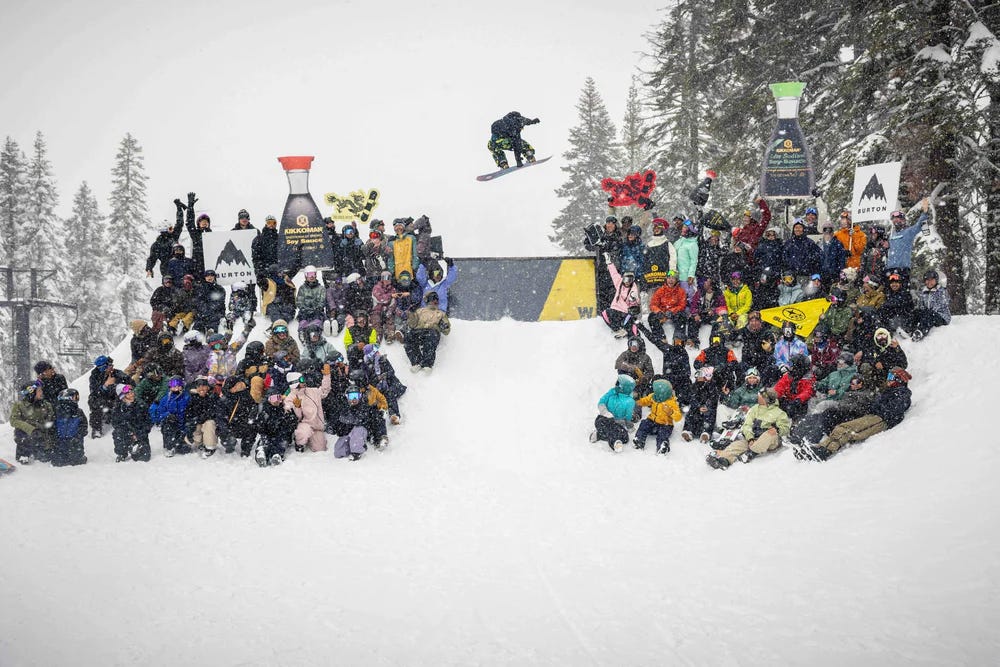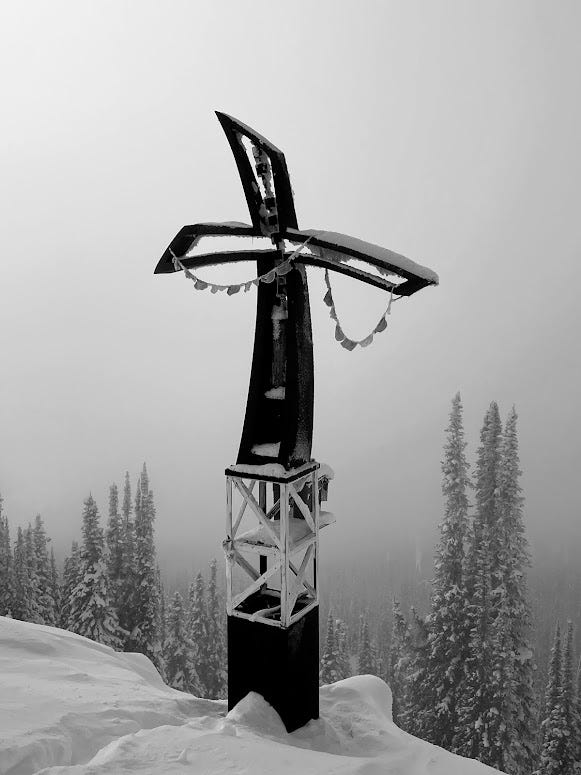Contest Culture: The Past, Present, and Future of Snowboarding
Part III: The Evolution Continues
The contest landscape is shifting faster than anyone anticipated. While established events continue to evolve, the most interesting developments are happening in spaces that barely existed five years ago. These aren’t traditional contests with podiums and prize purses. They’re cultural experiments that blend competition with creativity, and progression with pure fun.
What we’re witnessing is a fundamental reimagining of what competitive snowboarding can be when it serves the culture instead of trying to monetize it.
The Underground Rival
Some of the most innovative contest formats are emerging from the DIY scene, driven by riders who grew up watching contest culture lose its authenticity and decided to build something better. These events operate on different principles: participation over performance, creativity over technicality, and vibe over victory.
Holy Bowly represents this ethos perfectly. Started as a grassroots bowl session, it’s evolved into a traveling celebration that brings together skaters, surfers, and snowboarders around the shared love of riding transitions. The contest element is almost secondary to the session itself. No brackets, no elimination rounds, just pure progression happening in real time.
The Identity-First Approach
What started as a meme page in 2012 has grown into the largest global gathering of Asian snowboarders the Western hemisphere has ever seen. Soy Sauce Nation, led by Andrew “AK” Kelly, Nirvana Ortanez, and Max Tokunaga, has created something that transcends traditional contest culture entirely.
Their annual “Stir-Fry” event at Woodward Tahoe isn’t about determining winners and losers. It’s about creating space where cultural identity becomes a source of strength rather than isolation. The three-day format combines progression-focused riding with cultural celebration, industry panels featuring trailblazers like 686’s Mike West, and a gathering that feels less like a contest.
The genius lies in understanding that some of snowboarding’s most important work happens off the mountain. By celebrating what makes riders unique rather than trying to homogenize their experiences, Soy Sauce Nation has proven that authentic cultural celebration can drive progression and innovation in ways that traditional contests never could.
The Lifestyle Integration Phenomenon
Red Bull Heavy Metal has perfected the art of integrating contests into broader cultural experiences. Instead of treating snowboarding as an isolated sport, Heavy Metal presents it as part of a lifestyle that includes music, art, fashion, and street culture.
By bringing snowboarding contests to urban environments like Boston, Heavy Metal expands the sport’s reach while maintaining cultural authenticity. The format combines street-style obstacles with creative course design, but what sets it apart is the attention to cultural context.
The Terrain Innovation Labs
SLUSH The Magazine’s World Quarterpipe Champions creates playgrounds that inspire creativity rather than testing specific technical skills. The quarterpipe format allows for endless interpretation while maintaining a simple, accessible framework.
The genius lies in its simplicity. While World Quarters is a pro-only invitational, the quarterpipe format itself allows for endless creative interpretation. The same transition that one rider uses for technical progression becomes a canvas for another rider’s artistic expression. It’s terrain that rewards style and creativity over pure technicality.
The Educational Entertainment Hybrid
Pat Moore founded Methodology in 2017 with the idea of supporting snowboarding communities through local initiatives that go far beyond traditional contests. Their events combine riding with fundraising efforts that have benefited resort towns from Sierra at Tahoe to Brighton Resort.
Methodology events have raised money for skateparks, avalanche education through the Utah Avalanche Center, underserved youth programs such as STOKED, disaster relief funds, and Boarding for Breast Cancer. It’s contest culture reimagined as community service, where the competitive element serves a larger purpose of strengthening the scenes that support snowboarding.
The Peace Park Philosophy
Woodward’s Peace Park has taken terrain innovation in a different direction. Instead of building features that challenge riders to push their limits, Peace Park creates environments that encourage progression at every level. The philosophy is simple: build terrain that inspires confidence rather than fear.
Peace Park events prioritize inclusivity, safety, and positive progression over traditional competitive metrics. It’s a model that could influence how contests approach everything from course design to judging criteria.
The Technology and Sustainability Revolution
The most successful emerging contests leverage technology as integral elements of the contest experience itself. Live streaming, real-time scoring, and audience interaction are becoming standard features. Some events are experimenting with audience participation in scoring, while others use technology to provide more detailed feedback to participants.
Climate change is forcing contest organizers to rethink when, where, and how events happen. The most forward-thinking contests are building sustainability into their core operating principles, becoming more efficient, localized, and creative about making use of available conditions.
The Economics of Authenticity
The most sustainable emerging contests have figured out how to generate revenue while maintaining cultural authenticity. Instead of relying on large corporate sponsors, they’ve diversified revenue streams through product sales, content licensing, educational programs, and participant fees.
This economic model allows contests to maintain independence while providing value to multiple stakeholders. The key insight is that authenticity itself has economic value. Contests that serve their scenes well create loyalty and engagement that translates into sustainable business models.
The Participation Revolution
Perhaps the most significant trend in emerging contest culture is the emphasis on participation over spectatorship. The most successful new events create opportunities for audiences to become participants rather than passive observers.
Instead of clear distinctions between competitors and spectators, the best events create fluid boundaries that allow people to engage at whatever level feels appropriate. The result is contests that feel more like shred-togethers than competitions.
The Integration Opportunity
The most exciting opportunity in contest evolution lies in integrating the best elements from different models. Imagine contests that combine Natural Selection’s terrain innovation with Holy Bowly’s participatory spirit, Methodology’s educational approach with Peace Park’s inclusive philosophy.
The contests that will define the next era of snowboarding are those that consciously integrate lessons from across the spectrum of contest innovation. They’ll combine grassroots authenticity with professional production, technological innovation with cultural tradition, and competitive excellence with inclusive participation.
The Path Forward
The direction of contest evolution isn’t predetermined, but the opportunities are endless. Here’s what the next wave of snowboard contests could look like when organizers stop playing it safe and start serving the culture that actually matters.
The Craig Kelly Tribute at Baldface: Imagine a contest that honors the godfather of freeriding in the deep powder bowls of British Columbia. No course markers, no artificial features, just riders choosing their own lines through Baldface’s legendary terrain. Judging based on line choice, flow, and that indefinable quality Craig embodied: pure snowboard soul.
Doubles Pipe Sessions: Borrowed from skateboarding’s most clever format, doubles contests would put two riders in the pipe simultaneously, creating collaborative runs instead of individual performances. The magic happens when riders play off each other’s energy, setting up alley-oops, creating rhythm, and turning competition into conversation.
The Anti-Spin Movement: A contest format that bans rotations over 540 degrees, forcing riders to focus on what made snowboarding beautiful before it became a spin-to-win contest. Points awarded for amplitude, tweaking, grab variety, and smoothness. It’s time to bring back the method as a legitimate contest trick.
Digital HORSE Sessions: Take the playground game online with riders calling their tricks and global audiences voting on execution. Remote judging through livestreams, social media integration, and real-time audience participation. Contest snowboarding for the TikTok generation that still rewards genuine skill.
The events that will define the next decade won’t come out of shareholder meetings or the IOC. They’ll come from riders who understand that contests work best when they amplify what makes snowboarding special rather than trying to make it something else.
Contest culture isn’t dying or being reborn. It’s evolving into something more diverse, more authentic, and more relevant than it's been in decades. The evolution continues, and it’s all of ours to direct.






